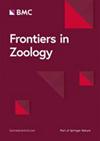Responses to extreme drought in wintering waterbirds: a multi-species approach
IF 2.6
2区 生物学
Q1 ZOOLOGY
引用次数: 0
Abstract
Climate change and anthropogenic activities are accelerating environmental changes, challenging wild animals’ survival. Behavioral plasticity, such as adjusting habitat selection and foraging activity, is a key mechanism for responding to rapid environmental changes in the Anthropocene era. However, this shift may expose animals to new challenges. Moreover, not all behavioral plasticity is adaptive, as evidenced by ecological traps. This study focuses on Poyang Lake, a Ramsar wetland and a critical wintering ground for waterbirds in the East Asian–Australasian Flyway. Historically, the migratory patterns of waterbirds were synchronized with the plant life cycle. However, recent hydrological regime changes have diminished suitable habitats and food resources, thereby posing significant conservation challenges for waterbirds. Utilizing multiyear satellite tracking data, we examined the variations in wintering home range and behaviors of four herbivorous waterbird species between natural and artificial wetlands in Poyang Lake under different hydrological conditions. Our results reveal significant differences in home range area and movement speed among species and across hydrological years. All species demonstrated a marked increase in their use of artificial wetlands under unfavorable conditions. Specifically, the Greater White-fronted Goose (Anser albifrons) shifted its distribution to artificial wetlands during drought years while favoring natural wetlands under normal conditions, indicating a stress-induced adaptation. In contrast, the Bean Goose (A. fabalis) and Swan Goose (A. cygnoid) displayed greater behavioral plasticity. Notably, the Siberian Crane (Leucogeranus leucogeranus) increasingly used artificial wetlands, likely due to human protection, raising concerns about potential ecological traps. Additionally, waterbirds foraging in artificial wetlands generally exhibited higher movement speeds during drought conditions. This behavior suggests maladaptation and a more dispersed distribution. Our study underscored the critical role of artificial wetlands in supporting migratory waterbirds during drought, though elevated movement speeds observed in these habitats suggest potential maladaptation. Species-specific responses raise concerns about ecological traps if these habitats fail to meet key ecological needs. To ensure long-term conservation, efforts should focus on preserving natural wetlands and enhancing the quality of artificial habitats. Future research should prioritize long-term monitoring to guide habitat management and address species-specific needs in the face of climate change and habitat degradation.越冬水鸟对极端干旱的反应:多物种方法
气候变化和人类活动正在加速环境变化,对野生动物的生存构成挑战。行为可塑性,如调节栖息地选择和觅食活动,是人类世时代应对快速环境变化的关键机制。然而,这种转变可能会使动物面临新的挑战。此外,正如生态陷阱所证明的那样,并非所有的行为可塑性都是适应性的。本研究以鄱阳湖为研究对象,鄱阳湖是拉姆萨尔湿地,也是东亚-澳大拉西亚迁徙路线上重要的水鸟越冬地。历史上,水鸟的迁徙模式与植物的生命周期是同步的。然而,最近水文状况的变化减少了适合的栖息地和食物资源,从而给水鸟的保护带来了重大挑战。利用多年卫星跟踪资料,研究了不同水文条件下鄱阳湖自然湿地和人工湿地间4种草食性水鸟越冬栖地及行为的变化。我们的研究结果揭示了物种之间和水文年之间的家园范围和移动速度的显着差异。在不利条件下,所有物种对人工湿地的利用均显著增加。具体来说,大白额鹅(Anser albirons)在干旱年份将其分布转移到人工湿地,而在正常条件下则倾向于自然湿地,这表明了应激诱导的适应。相比之下,豆鹅(A. fabalis)和天鹅鹅(A. cygnoid)表现出更大的行为可塑性。值得注意的是,西伯利亚鹤(Leucogeranus Leucogeranus)越来越多地使用人工湿地,可能是由于人类的保护,引起了对潜在生态陷阱的担忧。此外,在干旱条件下,在人工湿地觅食的水鸟普遍表现出更高的移动速度。这种行为表明不适应和分布更分散。我们的研究强调了人工湿地在干旱期间支持迁徙水鸟的关键作用,尽管在这些栖息地观察到的移动速度加快表明潜在的不适应。如果这些栖息地不能满足关键的生态需求,物种特异性反应引起了对生态陷阱的关注。为确保湿地的长远保育,我们应致力保护天然湿地及提高人工生境的质素。未来的研究应优先考虑长期监测,以指导栖息地管理,并在面对气候变化和栖息地退化时满足物种的特定需求。
本文章由计算机程序翻译,如有差异,请以英文原文为准。
求助全文
约1分钟内获得全文
求助全文
来源期刊

Frontiers in Zoology
ZOOLOGY-
CiteScore
4.90
自引率
0.00%
发文量
29
审稿时长
>12 weeks
期刊介绍:
Frontiers in Zoology is an open access, peer-reviewed online journal publishing high quality research articles and reviews on all aspects of animal life.
As a biological discipline, zoology has one of the longest histories. Today it occasionally appears as though, due to the rapid expansion of life sciences, zoology has been replaced by more or less independent sub-disciplines amongst which exchange is often sparse. However, the recent advance of molecular methodology into "classical" fields of biology, and the development of theories that can explain phenomena on different levels of organisation, has led to a re-integration of zoological disciplines promoting a broader than usual approach to zoological questions. Zoology has re-emerged as an integrative discipline encompassing the most diverse aspects of animal life, from the level of the gene to the level of the ecosystem.
Frontiers in Zoology is the first open access journal focusing on zoology as a whole. It aims to represent and re-unite the various disciplines that look at animal life from different perspectives and at providing the basis for a comprehensive understanding of zoological phenomena on all levels of analysis. Frontiers in Zoology provides a unique opportunity to publish high quality research and reviews on zoological issues that will be internationally accessible to any reader at no cost.
The journal was initiated and is supported by the Deutsche Zoologische Gesellschaft, one of the largest national zoological societies with more than a century-long tradition in promoting high-level zoological research.
 求助内容:
求助内容: 应助结果提醒方式:
应助结果提醒方式:


